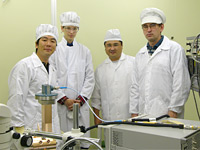 |
 |
|||||||||||||
|
|||||||||||||
|
|||||||||||||
An electron gun is a device that supplies electrons for an electron accelerator. There are mainly two types of electron guns: thermal-electron guns and photo-cathode RF guns. A thermal-electron gun is used for cathode-ray tubes in television sets and for electron microscopes. When a piece of metal is heated, it produces electrons. These electrons are accelerated by an electric field. In high-energy accelerators, radio-frequency electromagnetic waves are used to generate the field. In a thermal-electron gun, the beam bunch is compressed by a device called a buncher, and it generates bunches in about ten picoseconds. Timing is adjusted so that the bunch of this electron beam may ride on the wave of the radio frequency acceleration electric field, and it accelerates. KEK has been leading the development of photo-cathode RF guns, using electrons produced by a laser pulse. RF or Radio Frequency is used at the first-stage acceleration with an electric field. Immediately after the generation, the electrons are accelerated with a high electric field to beyond 100MV/m. The gun can control the loss of beam quality which happens immediately after the generation of electrons. In addition, the duration of the laser pulse defines the duration of the electron beam, so the gun can make short bunch beams without using the buncher. It can also generate an electron beam with a complicated bunch structure, such as the structure needed for the ILC, comparatively easily. Yoshio Kamiya (Waseda University) is working with Junji Urakawa as a joint researcher on the photo-cathode RF gun. This device generates electrons and promptly accelerates them, pulling them out into a RF cavity, the secret of technology. "The process requiring most care in making cavities is the cavity design and production process for accumulating RF," Kamiya said. Excellent industrial skills are needed to fabricate a cavity with micron precision. Two Russian researchers from the Joint Institute for Nuclear Reasarch (JINR), Yury Korotaev and Igor Kryachko, stayed at KEK for six weeks from 10 October to study the laser system of KEK's electron source and RF source. Korotaev has been involved in the Low Energy Particle Toroidal Accumulator (LEPTA) project at JINR since 1996. He is responsible for its control system and for diagnostics including the position sensitive system of low energy positronium flux. "JINR has the plan to create a test bench of a photo-cathode RF gun similar to that of ATF. I think KEK has a rich experience with building ATF. That is why we are trying to study not only the RF gun, but also related technologies. It will be very important for us to understand how the beam diagnostics works. I understand the special requirements to preparation for photo-cathode RF guns," Korotaev said. Kryachko has been involved in the spectroscopy of inductive coupling plasma since 2004. "I studied photo-cathode RF guns for the first time in KEK. Everyone at KEK always answers my question right away. They are very professional," Kryachko said. "The laser beam which is used at a photo-cathode RF gun is strongly polarised. It enables us to generate a polarised electron beam and thus receive strongly polarised x-ray radiation (in particular in spectroscopy)." JINR have big plans for their contributions to the ILC. They want to create a test bench, based on existing normal conductive accelerators, for testing some elements and systems of the ILC superconducting linac and the linac injector with an electron beam. The institute will develop a beam diagnosis device for the ILC. Between KEK and JINR, an umbrella agreement was signed in November 2000. Based on this agreement, they signed the Memorandum of Understanding on Accelerator Research and Development for International Linear Collider between Accelerator Division of High Energy Accelerator Research Organization (Japan) and JINR in May 2006. Grigory Shirkov, a chief engineer of JINR, said: "This MoU allows us to exchange resources more smoothly between KEK and JINR." Kaoru Yokoya, head of the Linear Collider Promotion Office at KEK, appreciates the merits of this MoU. "Compared to KEK's R&D, we think it is suitable to start cooperation research as the first step with the development of the photo-cathode RF gun of ATF. The development of this photo-cathode RF gun will soon be applied to the beam generation of STF, and we must keep up our collaborative relationship in the development of lasers." -- Nobuko Kobayashi |
|||||||||||||
| © International Linear Collider |
